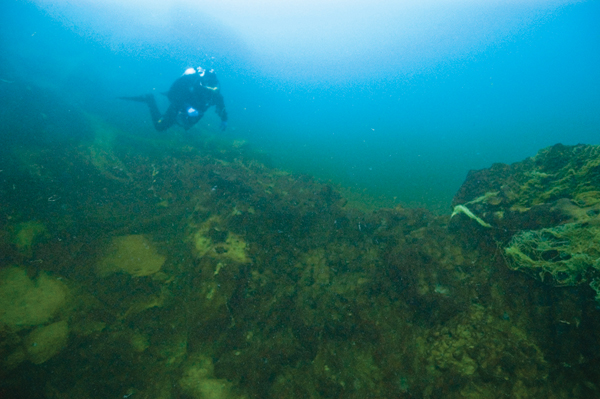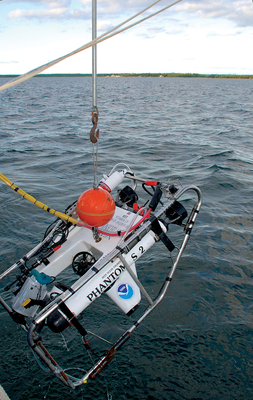
by Lindsey Doermann Thursday, January 5, 2012

In the sinkholes of Lake Huron, researchers are finding microbial life more reminiscent of the life found in ocean hydrothermal vents than that in freshwater lakes. NOAA, courtesy of Thunder Bay Sinkholes 2008

Researchers sent the Phantom S2 ROV into one of the sinkholes. NOAA, courtesy of Thunder Bay Sinkholes 2008
The Great Lakes hold the secrets of hundreds of ill-fated voyages in their notoriously treacherous waters. Shipwreck enthusiasts find a bounty of nautical relics preserved in their chilly depths. Only within the last decade, however, have explorers and scientists begun to reveal the secrets of a much different — and ancient — sunken treasure in Lake Huron.
Off the eastern shore of Michigan lie submerged sinkholes full of aquatic anomalies. Undetected until earlier this century, their mere existence underscores how little we know about lacustrine environments close to home. These pockets of water teem with microbial life similar to that found around deep ocean hydrothermal vents or beneath ice-covered Antarctic lakes, not the kinds of microorganisms normally found in our own backyards.
Scientists have been exploring these exotic environments over the past few years, and what they have discovered, they surmise, resembles what early life on Earth may have looked like. Studying the sinkholes and the microbial life therein could unlock clues to how life first evolved. What is more, researchers suspect that the strange sinkholes contain rare and possibly new lineages of microorganisms that could aid in new drug development.
Shipwreck hunters first tipped off scientists to the Great Lakes sinkholes. In 2001, the Institute for Exploration, an organization headed by Robert Ballard of Titanic discovery fame, conducted highresolution mapping of the bottom of Lake Huron in search of archaeological treasure. Imaging the lakebed underlying the Thunder Bay National Marine Sanctuary (off the northeast portion of Michigan’s Lower Peninsula) with side-scan sonar, the shipwreck hunters detected five round and rather puzzling depressions within a few kilometers of the coast. Their curiosity got them talking to biologists and geologists in the area.
Two years later, Ballard’s team and aquatic ecologists in the Great Lakes region, equipped with an underwater remotely operated vehicle, went back to take a closer look at the features. They returned with a fresh set of biological and geological questions about a lake that’s already seen its fair share of scientific scrutiny.
Before long, the true importance of these oddities became apparent: “These ecosystems in Lake Huron are analogs of the Proterozoic,” says Bopi Biddanda, a microbial ecologist at Grand Valley State University in Michigan and one of the leaders of the sinkhole science team. “They could be windows into communities that existed 3 billion years ago.”
Sinkholes dot the landscape in many areas of the world where water slowly dissolves limestone bedrock to open up subterranean caverns. When a tunnel nears the surface, the roof can cave in, forming a sinkhole. Much of the northern Great Lakes region consists of carbonate aquifers ripe for sinkhole formation. This limestone bedrock was formed about 400 million years ago, in the Paleozoic era, when central North America was covered by a vast shallow sea. The Lake Huron sinkholes probably formed when the area was still exposed to air after the retreat of the last ice sheets about 10,000 years ago.
The researchers have focused their attention on three sinkholes in Lake Huron: one is a footballfield- sized depression near shore, just one meter below the surface; another is a 50-meter-diameter depression approximately three kilometers offshore in 23 meters of water; and the third is a slightly larger hole 15 kilometers offshore and 93 meters below the surface. Though the features might be much more common than we think, says Val Klump, senior scientist with the Great Lakes Wisconsin Aquatic Technology and Environmental Research Institute in Milwaukee, Wis., there has been no additional funding to map more of the Great Lakes.
Still, since their discovery in 2001, the submerged sinkholes — so unexpected, curious and easily accessible — have attracted geologists, biologists and chemists seeking to understand just how the ecosystems within them function.
One of the first things they noticed is that the sinkholes — both shallow and deep alike — are filled with cloudy water. This contrasts starkly with the rest of the lake, which has been filtered clear by invasive zebra mussels. Biddanda and his team measured the anomalous water using a conductivity-temperature-depth system mounted on a remotely operated vehicle, and also had divers collect water samples to take back to the lab. They learned that the water in the sinkholes is both 10 times more conductive (meaning a lot saltier) and slightly colder than the surrounding lake; this evidence, they say, implies that groundwater must flow into the bottom of the sinkholes. En route to the lake, the groundwater dissolves minerals and evaporites from the surrounding limestone. The groundwater then fills the sinkholes with denser, salt-rich water that sits like a lens at the lake bottom and mixes very little with the rest of the lake.
Additionally, they discovered that the sinkhole water’s chemical signature is very different from the surrounding lake due to its journey through the ancient bedrock. The low levels of dissolved oxygen and high sulfate content of the water in the sinkholes are analogous to what researchers think the composition of shallow seas was like on early Earth, Biddanda says.
Once the team examined the water in the sinkholes, they set to work looking at the biological communities that inhabit them. Both shallow and deepwater sinkholes are teeming with microbial life, albeit of slightly different varieties. In the former, some sunlight still penetrates to the lake bottom. It is there that the sinkhole researchers and their team of divers found brilliant purple cyanobacteria mats blanketing the holes. Similar types of microbial communities have been uncovered only in very small pockets around the world, such as the sulfate-rich, groundwater-fed Lake Cadagno in Switzerland.
Though seemingly motionless, the purple sinkhole cyanobacteria actively battle to keep their place in the sunlight. Biddanda has witnessed in his lab how these microorganisms move collectively: When covered by a pebble, they will climb over it within hours. Similarly, cyanobacteria in natural lake settings resist burial by continually climbing past freshly deposited sediment and toward the light like terrestrial plants growing toward the sun. Beneath the purple mats, anaerobic organic sediments give off methane gas, which pushes the mats up into knee-high pillars — what Biddanda calls the Purple Ridge Mountains.
In the deepwater sinkhole, dubbed Isolated Sinkhole, researchers found a different form of microbial life. With no sunlight penetrating to this depth, the depression hosts white chemosynthetic microbes — what Biddanda views as cousins of the deep ocean extremophiles living around oceanic hydrothermal vents — that blanket the bottom and feed off of the sulfur-rich groundwater. Researchers think these organisms resemble the microbes that lived anaerobically 3 billion years ago on Earth.
About 2.5 billion years ago, the makeup of Earth’s atmosphere changed significantly with a dramatic rise in oxygen. This is a critical period in the history of the planet and the life on it, Biddanda says, and sinkhole organisms can provide a unique window back to this crucial transitional time in Earth’s history.
When University of Michigan geobiologist Greg Dick first learned of the purple cyanobacteria, he says, “I started thinking of them as early-Earth ecosystems, when cyanobacteria oxygenated the planet.” Photosynthesis as we know it today — oxygenic photosynthesis — uses water and produces oxygen. But in an ancient, anoxic world, primitive microbes performed anoxic photosynthesis, a process that relies on hydrogen sulfide.
The sinkhole cyanobacteria, it turns out, can do both kinds. Biddanda and Dick have found that these cyanobacteria utilize the low-oxygen/highsulfur water venting into the sinkholes, but that they can also switch over to oxygenic photosynthesis when sulfur runs low. At some point on an ancient Earth, Biddanda says, “some cyanobacteria discovered that there was a lot of water around and figured out how to use it.” Thus, these modern organisms could represent a pivotal point in the history of life on the planet: No one knows exactly how Earth’s atmosphere became oxygenated, and it’s possible, he says, that cyanobacteria with such flexible physiologies could have played a large role in oxygenating the atmosphere.
Going forward, Dick is collaborating with molecular ecologist Steve Nold of the University of Wisconsin at Stout, and is using new genomic methods to parse out how, and under what geological and chemical conditions, the sinkhole cyanobacteria behave. Because similar organisms could have been responsible for oxygenating Earth’s atmosphere, he says, decoding exactly how they choose a form of photosynthesis could fill in missing pieces regarding how life evolved on the planet. Even more, Biddanda says, the project has piqued the interest of astrobiologists considering what life might look like away from our planet. “Windows into the past like this are important,” he says, “because who knows what you’re going to find beneath the oceans of Europa, for example.”
In addition to providing possible analogs to early Earth and to life on other planets, the diversity of life found when sampling this microbial hot spot has led to an influx of biological data, some of which may also lead to discoveries of novel and potentially useful drugs.
Many drugs come from microorganisms, says Dave Sherman, a medicinal chemist at the University of Michigan. “We’re really excited about sources of new microorganisms, and there’s been relatively little work done in the Great Lakes,” he says.
Sherman has cultured some sinkhole microorganisms in his lab, testing to see if they show any potentially useful biological activity. Already he’s found that something in a variety of sinkhole cyanobacteria kills the anthrax bacteria. “It’s a long way from biological activity like that to a drug,” he cautions. “Is there a potential? Yes. But we won’t know for many years.” Nonetheless, he says, the possibility is exciting.
The sinkholes’ mere existence offers a reality check on how little we know about the Great Lakes and our coastal waters, says Ivar Babb, director of the National Undersea Research Center at the University of Connecticut. The recently revealed curiosities just offshore in Lake Huron not only provide an alternative to million-dollar research expeditions to remote parts of the planet, but they also bring a sense of the exotic to a workhorse of industrial shipping and playground of Midwestern boaters, Babb says. “It’s not the Mid- Atlantic Ridge, and it’s not on the other side of the world,” he says. “It’s right here.” And it begs the question: What other wonders lie beneath the waves in our own backyard?
© 2008-2021. All rights reserved. Any copying, redistribution or retransmission of any of the contents of this service without the expressed written permission of the American Geosciences Institute is expressly prohibited. Click here for all copyright requests.